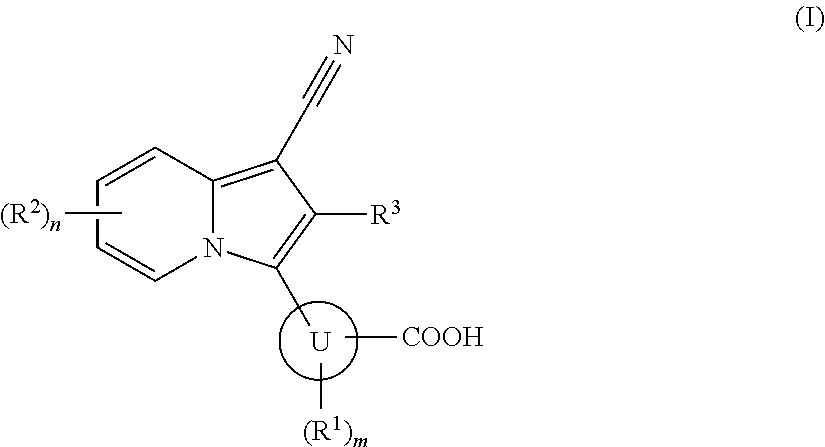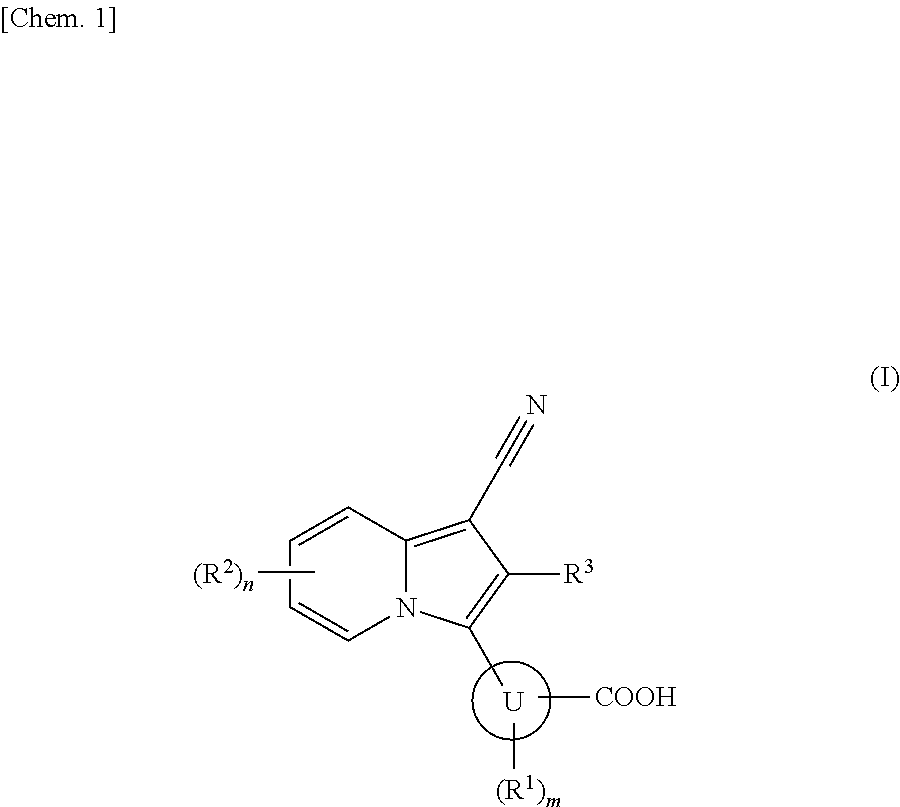Indolizine derivative and use thereof for medical purposes
a technology of indolizine and derivatives, applied in the field of indolizine derivatives, can solve the problems of increased incidence of liver disorders, adverse effects of uricosuric drugs, decreased excretion of oxypurinol, etc., and achieves excellent urat1 inhibitory activity, suppressed uric acid production, and excellent xanthine oxidase inhibitory activity.
- Summary
- Abstract
- Description
- Claims
- Application Information
AI Technical Summary
Benefits of technology
Problems solved by technology
Method used
Image
Examples
reference example 1
Indolizine-1-carbonitrile
[0196]To a solution of pyridine (4.0 g) in ethyl acetate (10 mL) was added chloroacetic acid (4.7 g) at room temperature, and the mixture was heated under reflux overnight. After the reaction mixture was cooled to room temperature, the precipitated solid was collected by filtration, and dried under reduced pressure to give 1-carboxymethyl pyridinium chloride (5.7 g). To a solution of the obtained compound (5.7 g) in toluene (300 mL) were added acrylonitrile (8.7 g), manganese dioxide (16.4 g) and triethylamine (4.0 g), and the mixture was stirred at 100° C. for 5 hours. The reaction mixture was filtered through a Celite pad, and the filtrate was concentrated under reduced pressure. The residue was purified by column chromatography on silica gel (eluent: n-hexane / ethyl acetate) to give the title compound (2.8 g).
reference examples 2 to 12
[0197]The compounds of Reference Examples 2 to 12 were prepared in a similar manner to that described in Reference Example 1 using the corresponding starting materials.
reference example 13
7-Trifluoromethylindolizine-1-carbonitrile
[0198]To a solution of 4-trifluoromethylpyridine (2.0 g) in ethyl acetate (10 mL) was added bromoacetic acid (1.4 g) at room temperature, and the mixture was heated under reflux overnight. After the reaction mixture was cooled to room temperature, the precipitated solid was collected by filtration, and dried under reduced pressure to give 1-carboxymethyl-4-trifluoromethylpyridinium bromide (1.0 g). To a solution of the obtained compound (1.0 g) in toluene (10 mL) were added acrylonitrile (0.93 g), manganese dioxide (0.91 g) and triethylamine (0.42 g), and the mixture was stirred at 100° C. for 5 hours. The reaction mixture was filtered through a Celite pad, and the filtrate was concentrated under reduced pressure. The residue was purified by column chromatography on silica gel (eluent: n-hexane / ethyl acetate) to give the title compound (0.31 g).
PUM
| Property | Measurement | Unit |
|---|---|---|
| temperature | aaaaa | aaaaa |
| acid production | aaaaa | aaaaa |
| nucleic acid | aaaaa | aaaaa |
Abstract
Description
Claims
Application Information
 Login to View More
Login to View More - R&D
- Intellectual Property
- Life Sciences
- Materials
- Tech Scout
- Unparalleled Data Quality
- Higher Quality Content
- 60% Fewer Hallucinations
Browse by: Latest US Patents, China's latest patents, Technical Efficacy Thesaurus, Application Domain, Technology Topic, Popular Technical Reports.
© 2025 PatSnap. All rights reserved.Legal|Privacy policy|Modern Slavery Act Transparency Statement|Sitemap|About US| Contact US: help@patsnap.com



